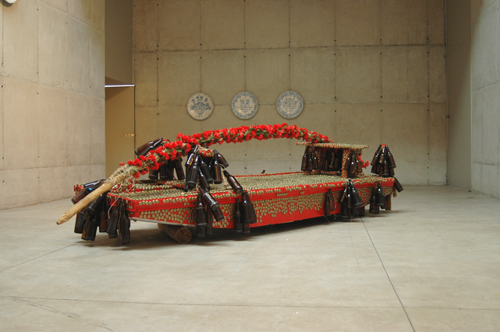ARTFORUM
Outubro/October 2006
 |
João Pedro Vale. Foi bonita a festa, pá. 2006
Exhibited as part of the group show “Neobarroco” in São Paulo along with
works by Camila Sposati and Friederike Feldmann, the most recent large-scale
sculpture by the Portuguese artist João Pedro Vale, Foi bonita a festa, pá (The Party Was Beautiful, Yes), 2006, was
constructed from a jangada, a balsa
raft from the northeast of Brazil. This craft seems particularly appropriate to
its situation in this gallery, the work of Paulo Mendes da Rocha (winner of
this year’s Pritzker Prize), who has created a long, narrow, very high nave,
much like an overturned boat.
Let us examine the metamorphoses and dislocations that Vale has
performed on this raft (instead of the caravel of this colonialist ancestors)
with which, as a Portuguese, he arrives today in Brazil. Vale painted the boat
red, generating maximum contrast with the browns and golden yellows of its
decorations: empty beer bottles and their caps. The red and gold recall, above
all else, the Catholic Baroque theatricality that marks the Portuguese heritage
in Brazil, and recall as well the red flags that played a major role in
Portugal’s democratic revolution of 1974. The so-called Carnation Revolution is
further evoked here by an arch of red plastic carnations that extends along the
boat like the arches that typically decorate popular celebrations. The
evocation of popular conviviality finds its most striking expression in the use
of bottle caps from Sagres beer as if they were ornamental jewels.
Sagres is the name of a town in southern Portugal, the site of the
school where many fifteenth-century navigators were trained. The play between
the “rich” effects of colour and light and “poor” materials, between luxury and
kitsch, is part of dialectical play of contradictions that characterize this
sculpture and the whole of Vale’s work.
A similar formal and symbolic dislocation using objects related to
colonial expansion is evident in a set of thirteen smaller sculptures Vale
presented in Vienna. Here the references were to objects in cabinets of
curiosities such as that of Emperor Maximilian II, housed today in the
Kunsthistorisches Museum in Vienna. A product of the anthropological curiosity
and the fantasies associated with colonial exploitation, these objects were
intended to illustrate the exoticism of distant lands, supposedly inhabited by
strange beings like the unicorn (whose horn turns out to be a narwhal’s) or the
“wild man” (an African slave covered in goatskins) – this cruel invention being
the reference in one of the most successful pieces in the Vienna exhibition, Ecce Homo, 2006. The shape of a trophy
cup transforms itself into an exotic body, made with glue from a glue gun, a
wig balanced on the inverted horns of a Viking carnival helmet lined with
leather and gilded tacks, and the tip of an umbrella. A necklace of
mock-tortoise pendants and a duster made of Chinese rooster feathers complete
the assemblage.
Vale appropriated and metamorphoses pre-existing objects, using both
ordinary and uncommon materials to sabotage the distinction between beauty and
horror, naïveté and sophistication. Popular forms of creativity are placed in
the service of an analysis of colonialist fantasies; demystification of the
fictions of domination opens the path to a hybrid multiplicity of egalitarian
possibilities for a plastic and symbolic interplay.
|
......................................
Texto traduzido para inglês por Clifford E. Landers e publicado na revista mensal Artforum, na edição de Outubro de 2006, por ocasião da exposição Novo-Barroco, Galeria Leme, S. Paulo, Brazil.

Sem comentários:
Enviar um comentário
Nota: só um membro deste blogue pode publicar um comentário.